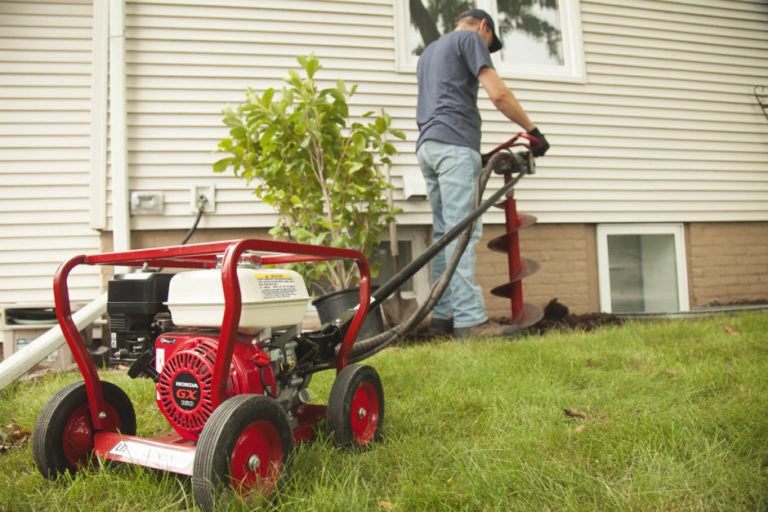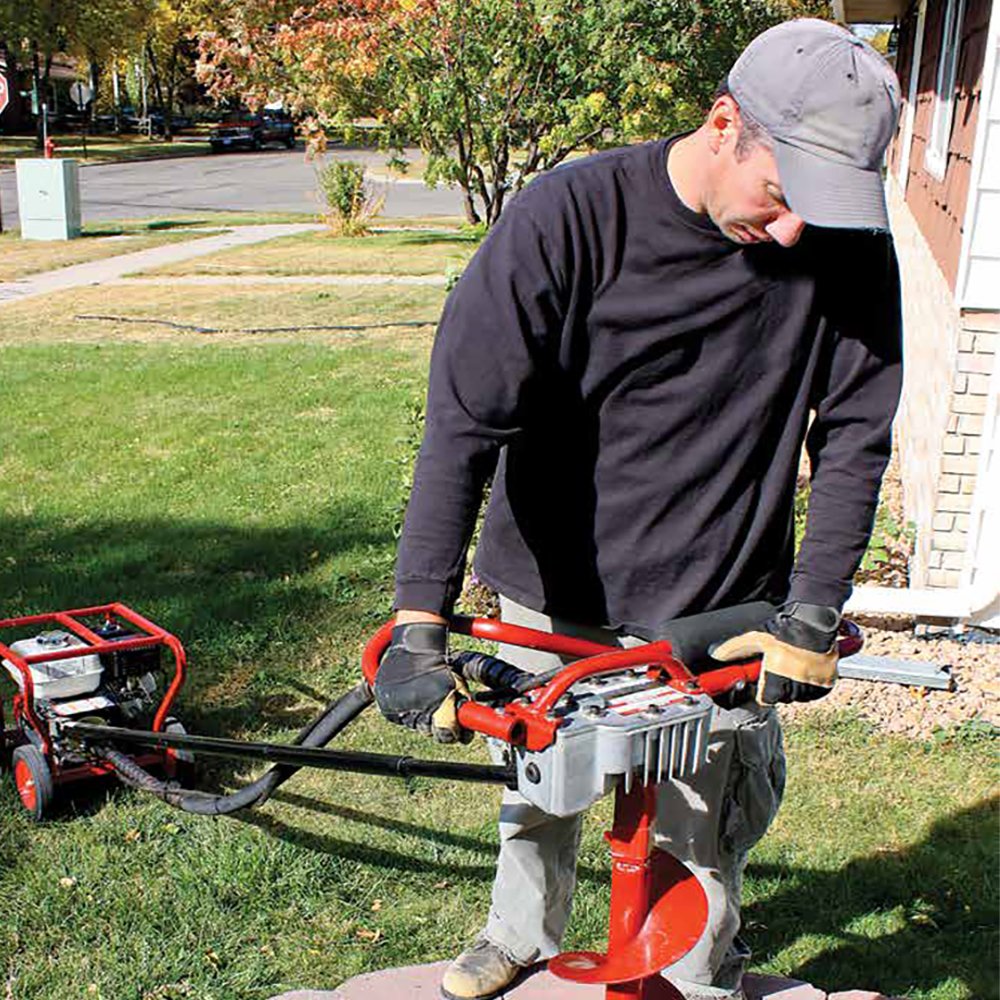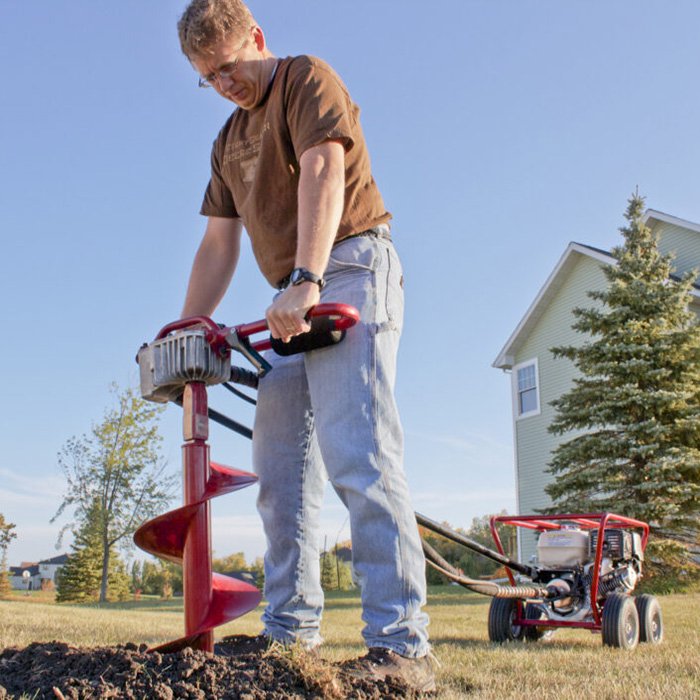Mechanical Earth Drill Safety Check & Troubleshooting
Proper safety inspection and precautions should be taken every time you operate your mechanical earth drill. Safety checks pertain to more than just the equipment itself; it also applies to the proper protection of the operator, surrounding people, and the environment. Though safety instructions are provided in the manual of all equipment, below are the recommended safety checks you should perform when using your mechanical earth drill.
Proper Protection & Operation
- Read and understand the operator's manual for the machine and the engine.
- Wear proper protection, such as glasses, closed-toe shoes, and clothes that are not overly loose.
- Keep hands, feet, and clothing away from moving parts while operating.
- Keep surrounding people clear of the machine (10 ft away).
- Keep leg pad against leg while drilling to maintain control.
- Keep all safety shields or devices in place while operating.
- Do not remove the auger from the hole while it is turning.
- Always operate at full throttle.
- Do not operate with damaged or missing parts.
- Turn the engine off to adjust or service the machine.
- Do not use replacement engines greater than eight (8) horsepower.
- Check that you will not drill into utility lines.
- Check the type of soil you are drilling into so that you are using proper points and blades.

Performing A Safety Check On Mechanical Earth Drills
- Check that the torque tube is correctly installed.
- Check for damaged or missing parts.
*Engines are shipped without oil or gasoline and will need oil and gasoline maintenance.
*The Transmission and Flexible Shaft are shipped fully oiled/greased and ready to use but require maintenance.
Check Transmission
*Recommended Oil is Amalie Tri-Vis Plus Oil 80/85/140.
- Check that the transmission has been properly lubricated. To add oil, hold it so that the top is level, remove the pip plug, squeeze the oil into the transmission until full, and replace the pipe plug. Pipe plug must be replaced and tightened to 10 ft-lbs.
Check Flexible Shaft
*Recommended grease is Lubriplate Portable Tool Grease - GR-132.
- Check the flexible shaft for tears and breaks on the rubber casting. If small, duct tape or shrink tubing may be used; if large and the wire is torn, the housing must be replaced.
- Check the core for broken wires and kinks. If sharp kinks or broken wires are found, the core must be replaced.
- Clean and grease the flexible shaft. Remove the flexible shaft and wipe off old grease. Clean the inside of the flexible shaft. Then, apply a light coat of grease to the core and reassemble.
Check The Clutch and Throttle Bracket
- Check the clutch while lubricating the flexible shaft. If excessive slippage occurs, clean the shoes and drum or replace them as needed.
- Check the engine for proper idle speed (1900 rpm).
- Check for stretching, discoloration, and broken clutch springs and clutch shoes.
- Inspect the throttle cable and throttle bracket. The throttle lever should pull smoothly and freely.
- Check that the throttle bracket is fully engaged before the lever "bottoms out" against the handlebar.
- Check that the clip moves over the rivet head when the throttle is fully engaged. If binding occurs, remove the clip, twist slightly, and reinstall.
Troubleshooting
Engine Will Not Start
- Toggle Kill Switch on the handle is off.
- The torque tube is not connected at the engine end.
- "Oil Guard" protected engines must be filled with oil to full mark on the dipstick or to the point of overflowing.
- If the light inside the engine on/off switch flashes (Briggs & Stratton only), this is an indication that the oil level is low.
- The fuel level is too low in the gas tank.
- Spark Plug is fouled.
Cannot Connect Or Disconnect Auger
- Foreign Matter clogging adaptor.
- The spring and button on top of the auger are bent or broken.
- The adaptor is bent.
Auger Turns Too Slowly And Will Not Dig
- Too much downward pressure or binding on the side of the hole. Hold back, if necessary, to allow the auger to turn at full speed.
Auger Turns But Will Not Dig
- Foreign matter is collected around the point.
- The point or blade is dull.
- Use a carbide blade for hardpan soil.
Auger With Extension Will Not Dig
- Auger or extensions bent or running out of line.
Transmission Over-Heats
- It is normal for the transmission to run hot to the touch. If it is very hot, check for proper oil and free turning.
Auger Turns When Engine Is Idle
- The engine idle is set too high.
- The sliding wire clip on the throttle bracket stuck. (Should move freely when the throttle lever is closed.)
- The clutch Spring is broken.
For more information, please reread the operator's manual for Little Beaver Mechanical Earth Drills or check out more articles in the Resource Hub.




